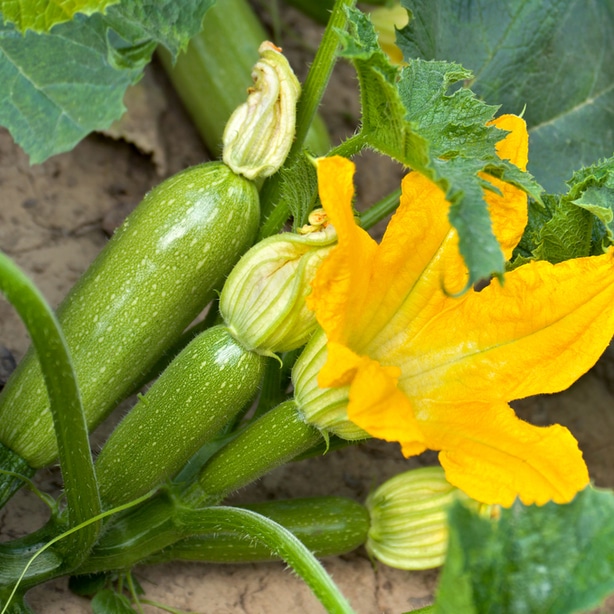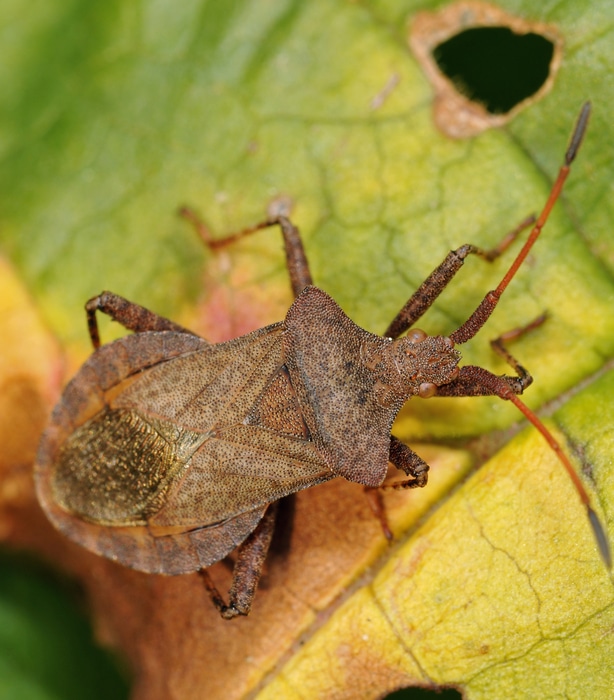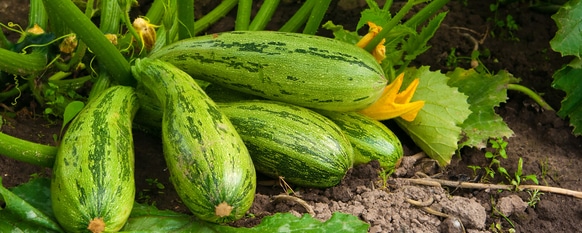As a vegetable that grows on an herbaceous vine, this green summer squash is easy to grow and easy to cook. You can chop it up for a quick side dish to go with chicken or port; you can shred it to bake some bread or make fritters, and you can even fry the blossoms for a delicious appetizer. Best of all, you don’t have to be a master gardener (or a master chef) or have a large plot of land to grow zucchini successfully. Their bushy habit makes them good contenders for potted growth.
Read on to learn all the tips on sowing, planting, growing, and harvesting this tasty vegetable. We also cover its appropriate care. Before you know it, you’ll be harvesting a bounty of delicious squash.
You’ll also want to check out our rhubarb growing guide for a vegetable that can add a beautiful tart flavor to your pies!

General Information
Zucchini (Cucurbita pepo) are considered a warm-season crop that is a member of the Cucurbitaceae family. All summer squashes—crookneck, yellow squash, patty pan, and zucchini—belong to the same species and genus.
Although many people think of the vegetable as long, green, and cylindrical, other colors and shapes exist. Depending on the variety, the fruit can be striped or splotched and range in color from almost black and dark green to yellow and cream-colored. Some cultivars have a round shape.
The vegetable’s thin skin and seeds are edible. Its inner flesh is quite tender, has a mild flavor, and doesn’t take long to cook.
Fruit size depends on the variety. Some types grow up to 20 inches long and can weigh over 10 pounds. Most cultivars average around 6 inches long with a 3- to 4-inch diameter.

Varieties
One look at a seed catalog, and you’ll be amazed at the number of different varieties that are available. Although the shape of the vegetable may vary, all varieties have the same mild and flavorful taste. All require the same conditions and care for healthy growth. And all will give you a bounty of delicious squash.
Black Beauty
This heirloom produces 6- to 8-inch-long, green-black fruit. It has a typical cylindrical shape. Plants have an open habit, growing around 18 inches tall and 3 feet wide. It takes approximately 50 days before fruits are ready to harvest.
Golden
This cultivar’s fruits are golden yellow and are best at 6 to 8 inches long. It grows about 2 feet tall and spread around 48 inches. Fruits mature in approximately 54 days.
Eight Ball
This variety produces round, 4-inch-long, dark-green fruit. The flesh has a buttery and nutty flavor. The productive vines grow around 2 feet tall and 48 inches wide. Zucchini are ready to harvest in 55 days.
Green Tiger
This is a variety with 8-inch cylindrical fruits that are striped in light and dark green. Plants grow about 2 feet tall and spread 12 to 24 inches. Fruits are ready to harvest in 55 to 60 days.
Sowing Seeds
Germinate seeds when outdoor temperatures are between 65°F and 105°F. For germination, soil temperatures need to be at least 65°F. The warmer the temperatures, the quicker germination occurs. The plants grow best in loose, fertile soil with a pH of 5.8 to 6.8. In prime conditions, seeds should sprout in a week or less.
If needed, amend the soil with well-rotted manure or compost. Work it into the soil to a depth of about 6 inches.
Create hills for the seeds. Hills warm earlier and drain better than rows. Space multiple hills about 3 to 4 feet apart. Distribute four to five seeds per hill, setting them about 1 inch deep. Seedlings should emerge in five to 10 days.
Once the seedlings reach several inches tall, thin to the healthiest two or three. The squash has a sensitive root system, so make sure you don’t disturb the healthy roots while removing the weakest seedlings.
If you decide to grow in rows, space the seeds about 4 inches apart. Space rows 4 to 5 feet apart. Thin the seedlings so that you have one zucchini every 12 inches.
Whether setting up hills or rows, water the site after planting.

Getting a Head Start
You can get a head start on things by germinating seeds in peat pots three to four weeks before transferring them into the garden. Sow one or two seeds per pot and keep the soil moist but not soggy. Once germinated, thin out the seeds, leaving only the healthiest seedling. Situate the pots in a warm and sunny location indoors.
Once the weather warms, you can move the entire pot into the garden or a pot. Space each one about 1 to 2 feet apart.
Care
For zucchini to grow properly and produce fruit, they require proper care. Full sun and regular watering if it doesn’t rain enough are essential. Regular moisture is especially important while it is actively producing fruit. You should fertilize the garden periodically with a vegetable-safe product.

Amount of Sun
Grow the squash in a site that receives six to eight hours of full sun daily. If you’re growing it in a pot, place it in an area that gets sun throughout the day. Too much shade affects growth, flowering, and fruit production. If your area is extremely hot and dry, some afternoon shade is okay.
Water Frequency
While seeds are germinating and then again when the plant is budding and producing fruit, the squash requires consistent moisture. How much water is needed depends on your local weather conditions. If your conditions are hot and dry, you’ll probably have to water daily. This is especially true if you are growing your zucchini pots. The soil in pots dries out quicker than that in the garden.
When watering, it’s best to water deeply. This assures the moisture reaches the root system. Water early in the day. This way, any water that gets on the foliage dries before nightfall. This helps prevent problems with disease.
Don’t stress if your squash’s foliage seems to wilt during the hottest portion of the day. This is a natural occurrence. Once late afternoon arrives and leaves are no longer wilting, moisture levels are sufficient. If not, water well. An inch of water applied weekly is adequate. If your plant is growing in a pot, water until it runs out of the pot’s bottom drain holes.
Using several inches of organic mulch helps the soil retain moisture. It also helps in reducing unwanted weed growth.
Fertilization
When growing, it’s essential to feed them at important stages during their growth. Incorporating several inches of well-rotted compost or manure when preparing the bed for the seedlings is best. This helps them get a great start. You also want to feed the squash when flowering begins and during the period of harvesting.
When the first flowers start to develop, look for a well-balanced fertilizer blend. Use a product that does not have a high nitrogen component. Otherwise, the plant might grow more leaves than flowers. A fertilizer high in phosphorus promotes flowering. Water your plants well after applying.
You can work in another application of well-rotted manure. Using a foliar spray of liquid fish emulsion or kelp also works well.
For those plants in pots, use a water-soluble blend. You can also use the foliar spray of the liquid fish emulsion or kelp.
Harvesting
Harvesting a bounty of fruits is what every gardener waits for. The average plant produces anywhere from three to nine pounds of fruit during the growing season. Since they can grow an inch or two daily, you’ll need to check each day to see if there are zucchini to harvest.
The fruits taste best when picked while they are small. Those allowed to grow into large squash lose their flavor, become pulpy, and might taste bitter.
Harvesting zucchini promotes new flower production, which leads to more fruit.
Don’t pull the squash from the vine as you can damage the stem. It’s best to cut the fruit off the vine using scissors or hand pruners. Be sure you use clean tools. Otherwise, you can unintentionally transfer a disease or pest to the vine.
Once harvested, store the fruit in the refrigerator unwashed. They’ll keep just fine for around ten days.

Growing Tips
If you’ve waited until frost has left your area and prepped the bed, you’re off to a good start when it comes to growing healthy zucchini. Giving them proper water and nutrients also guarantees good growth. However, there are some additional things you need to pay attention to, like pollination and keeping the area weed-free.
Remove Weeds
It’s important to put your crop into a weed-free bed. It’s also essential to remove any unwanted growth from the beds. Weeds are harbingers of disease and pests. So, check the area daily and remove any weeds that are taking root.
Since they have sensitive root systems, you don’t want to dig deeply around plants. It’s easier to pull out the unwanted growth while it’s still young.
Using an herbicide to remove weeds is not recommended. Accidentally getting the product on your zucchini squash can end up killing the plant or the leaves.
Pollination
Zucchini produce both male and female flowers on the same vine. Nature is usually pretty good at pollinating the flowers. Beneficial pollinators like bees and other insects transfer pollen from the male flowers to the female flowers. This results in fruit. However, if pollinators are lacking, you’ll have to play the part instead.
Although the two yellow flowers look very similar, it’s easy to tell a male from a female if you look closely. The yellow male has a long, thin stem and doesn’t contain the tiny immature fruit found in the base of the center of the female flower.

Don’t be surprised if there are mostly male flowers when the blooming season first begins. This is perfectly normal. The male blooms develop first so that they are ready to pollinate the female flowers.
In many urban locations, bees might not be plentiful enough to thoroughly pollinate all the flowers. In that case, you need to pollinate by hand. Fortunately, this is an easy process.
The flowers open in the morning and last only for a day. So, the best time to hand-pollinate is early in the morning. Take a small paintbrush, stick it in the center of the male flowers, and remove some of the pollen. Then, carefully transfer the pollen into the center of the female flower.
You can also remove the male bloom from the vine and rub it over the center of the female flower.
Potential Problems
Although growing zucchini is relatively easy, you need to keep your eyes open for potential problems. If you identify and address them early, your garden will remain healthy and produce a bounty of fruit.
Importance of Space
To reduce the danger of disease, it’s important to give the plants the space they need. Air circulation between plants is imperative to healthy, problem-free growth. Check the seed packet and note the projected mature width of your variety. Thin the seedlings according to instructions on the seed packet.
It’s best to keep multiple plants at least a foot apart. Depending on the ultimate size at maturity, you may have to thin to a larger distance.
Blossom End Rot
If the soil in your yard lacks calcium and moisture, plants can develop blossom end rot. It’s easy to identify: The blossom end of the fruit becomes leathery and sunken.
If you don’t address this problem, there will not be any fruit. Luckily, there’s an easy fix. Water your garden regularly and feed it using a calcium-rich fertilizer.
Some products specifically treat the problem. You usually mix the concentrate in water and spray it over the garden.
Powdery Mildew

Powdery mildew is a fungal disease that usually develops later in the season. It shows itself by coating both sides of the foliage in a white powdery-looking substance. In most cases, the problem doesn’t affect growth. However, in severe cases, it can impede growth and thus fruit development.
The best prevention is ensuring that there is enough space so that air can circulate between the plants. Water regularly and early in the day to control the problem.
If the foliage becomes infected, remove it using clean tools. You can also easily prevent the problem by spraying your zucchini with a solution of milk and water. Mix one part milk with two parts water. Treat on a sunny day without a forecast of rain. Reapply every ten days to two weeks during the growing season.
Squash Bugs

Squash bugs can be troublesome pests. They are easily mistaken for stink bugs, but squash bugs are smaller. They are around 1/2 inch long, brown or gray, have flat backs and orange stripes on their abdomens. Squash bugs suck out the plant’s juices, causing spotting and wilting foliage. The leaves eventually brown and die. When untreated, the problem leads to death and a loss of fruit.
Check the foliage daily for signs of pests or their eggs. The squash bug will lay its eggs on the underside of the leaves. Pick off the eggs and drop them into a container of soapy water. At night, place a board next to the crop. The bugs will congregate underneath it to spend the night. In the morning, just step on the board to smash them. You can also treat the problem with the insecticide carbaryl. Always handle and apply according to product directions.
Prevent the problem by placing row covers over the crop. Remove when flowers start developing.
Squash Vine Borers

Squash vine borers can quickly decimate your zucchini. The pest is a moth that lays its eggs on your crop and the larvae bores its way into the stems. They can also damage the fruit. The pest is only problematic in the eastern sections of North America. It’s imperative to notice and treat the problem before the eggs hatch.
The first sign of trouble is wilting foliage. Check around the zucchini’s base to see if you notice any yellowish-orange sawdust-like material. This is a sign the pest has bored into the stem.
The pest feeds on the inner stem. This results in it rotting and eventually dying. If you slice the stem’s entry point lengthwise, you can find and remove the larvae. Use caution and clean tools when making your cuts. Mound moist soil over the wound, so it heals.
Controlling the problem can be difficult. You can plant early in the season before pests become active in the middle of summer. Use row covers and only remove them when the plants are about to bloom. Create a barrier around the base of the stems. Wrap the stems in foil or nylon stockings. Use diatomaceous earth early in the season. Sprinkle the product around the stem and reapply after any rain. If necessary, you can use the insecticides carbaryl, permethrin, or Bacillus thuringiensis v. kustaki. Follow label instructions and apply it to the stems.
Cucumber Beetles

Cucumber beetles are small and yellow, with spots or stripes. They come out of their dormant stage just as the warm weather of spring arrives. Their bright color makes them easy to identify. The pests feed on the foliage as well as the fruit. Fortunately, you have several options for prevention and treatment
First, you can place row covers over your crop. Just make sure to remove them once the blooming stage begins to assure pollination. Hanging sticky traps next to the crop also works well. The traps will capture the cucumber beetles and prevent further damage.
If you follow these guidelines, you will be able to harvest fresh zucchini for most of the summer.


